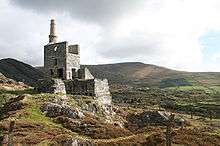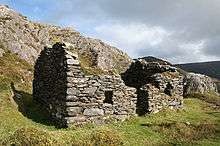Allihies Copper Mine Museum
The Allihies Copper Mine Museum (ACMM) is a museum dedicated to the history of copper mining in the Allihies area in County Cork. It is situated on the Wild Atlantic Way.
Musaem Mianaigh Umha na nAilichí | |
 | |
 Location within Ireland | |
| Established | 2007 |
|---|---|
| Location | Allihies, Beara Peninsula, County Cork, Ireland |
| Coordinates | 51.6390°N 10.0456°W |
| Type | Copper mining museum |
| Website | www |
History
The industrial mines in Allihies date back to 1812, when they were first opened by John Puxley. Mining activity reached its peak there in 1845, when the mines employed around 1600 people, after which the mines suffered with the local area during the Famine.[1] The mines were operational until 1962, when they were finally closed. Large Cornish engine houses were constructed around the mining site, ruins of which survive today. These were used to pump out water to allow for deeper mining, and to transport miners and equipment down shafts that went below sea level.[2] The site still contains a number of engine houses, mining shafts and a church. These were constructed by and for the Cornish miners who were brought to the area in the 1800s to mine copper ore.[3] Once the mine became unprofitable, many of the miners emigrated to Butte, Montana.[4][1]
The museum is housed in a renovated Methodist church dating from 1845.[5] It was officially opened by President Mary McAleese on 13 September 2007, after ten years of work by the Allihies Mines Co-op, a group that was formed to preserve the history of the area and mining heritage,[6] supported by the Mining Heritage Trust of Ireland.[4]
Exhibitions and tour

The exhibitions cover all aspects of the history of copper mining in the area, from prehistoric times all the way up to the nineteenth century and the Industrial Revolution. The displays also cover the local geology and the social history of the mining heritage.[5] The collections contain examples of mining equipment and tools from the various eras of activity.[7] The exhibition space is also used to display artworks, with local and International artists such as Charles Tyrrell, Cormac Boydell, Rachel Parry, Tim Goulding and Margaret Fischer Dukeman exhibiting there.[8]
The trust has begun work to extend tours into the mines and other areas, and started the restoration of Man Engine House.[4]
References
- Bunbury, Turtle. "The Story of the Butlers of Ballyglasheen, Co Tipperary & The Harringtons of Milleens, Co Cork". Turtle Bunbury. Retrieved 26 May 2015.
- "Cork Nostalgia – Remembering our mining past". The Evening Echo. Archived from the original on 27 May 2015. Retrieved 26 May 2015.
- "The Spread to Other World Regions". Cornish Mining World Heritage. Archived from the original on 27 May 2015. Retrieved 26 May 2015.
- "Allihies, Castletown-Bearhaven Copper Mines, Beara Peninsula, Co. Cork, Ireland". mindat. Retrieved 26 May 2015.
- "Allihies Copper Mine Museum". The Heritage Council. Archived from the original on 27 May 2015. Retrieved 26 May 2015.
- "Opening of Allihies Copper Mine Museum" (PDF). Industrial Heritage Association of Ireland Newsletter. 31: 7. 2008. Archived from the original (PDF) on 2012-02-12. Retrieved 26 May 2015.
- "Allihies Copper Mine Museum". Ask About Ireland. Archived from the original on 2015-05-27. Retrieved 26 May 2015.
- Tipton, Gemma (24 July 2010). "In an art beat". The Irish Times. Retrieved 26 May 2015.